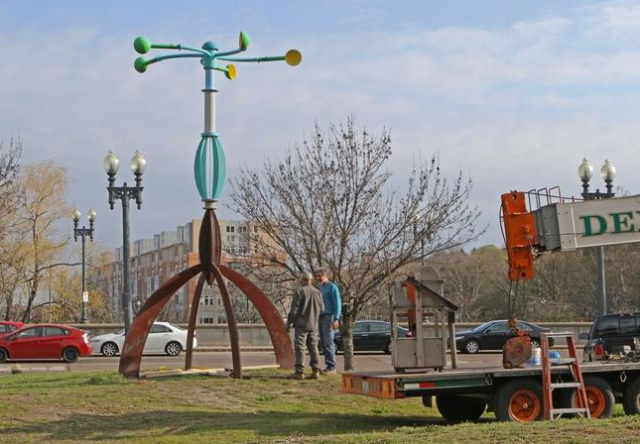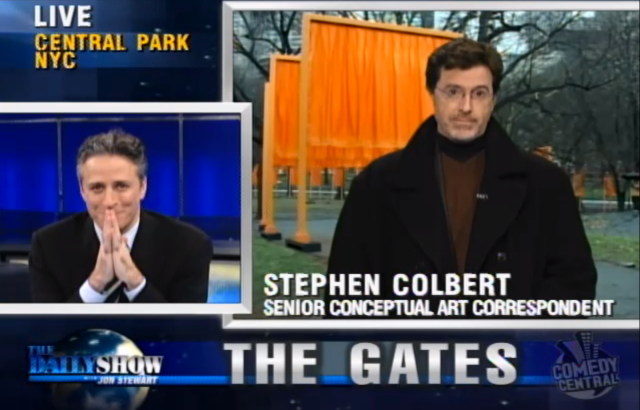
Sculpture by Donald Gerola on Parcel 12, or Bad Sculpture Park. (Providence Journal)
The grassy triangular plot of land at the corner of Kennedy Plaza and Burnside Park in downtown Providence – officially Parcel 12 of Capital Center – is unofficially called Bad Sculpture Park. A hotel is going to be built there, finally, and the bad sculpture is being taken away.
The sculptor, it turns out, is Donald Gerola, of Pawtucket, who moved here a decade ago from New York. Today’s Providence Journal has a piece by Mark Reynolds, “Sculptor dismayed by lack of acceptance,” that, perhaps without intending to do so, expresses many home truths about art and public taste.
He’s [also] in the process of retrieving four of his sculptures from public exhibits on Hope Street in Providence, at Pawtucket’s Slater Mill and at the Courthouse Center for the Arts in South Kingstown “I should never have brought them to Rhode Island,” he says. “I really regret it all,” adds Gerola, who once stretched 30,000 feet of colorful synthetic fabric cord across the Blackstone River to create an abstract weaving near the old Slater Mill.
Other transplants like Gerola and native Rhode Islanders, too, have followed big dreams and felt stymied by politics or lackluster economics or their own miscalculations. The nature of Gerola’s experience, which involves public art and ambitions of great scale, is one of the rarer tales of regret.
Between the lines is regret that the public often chuckles at art like this. I like to think I played a bit part by calling Parcel 12 “Bad Sculpture Park.”
But do not blame Gerola for this. He may have great talent as an artist within him, but he came up within an artistic milieu that encourages artists to believe they can make a living creating lesser art, work of often childish fatuity. Reynolds reports that Gerola works in a vein that resembles Christo, the artist who cloaks buildings in colorful tarps. This is not art, it is publicity.
Christo’s work was spoofed by Stephen Colbert on The Daily Show a few years ago with a hilarity that was probably far more profound, as a statement of art criticism or even of cultural criticism, than even Colbert or Jon Stewart realized. Here is “The Gates,” and its best passage:
Jon, “The Gates” is a triumph of contemporary installation art. Each gate redefining its section of the park not as a private place for public reflection but as a public place for private reflection. Juxtaposed with the barrenness of mid-winter, “The Gates” posits a chromatic orgy. This riot of color achieves a rare redefamiliar- ization with the nature of place/time, the “whatness” of our “whereness.” No longer framed … I’m sorry, I’ve run out of crap.
The skit’s “final act of resandwichment” might equal that. Check it out.
People who want to become artists in America and elsewhere are not encouraged to stretch their talents to create serious art that the public consciously or unconsciouly identifies and reveres as such. Institutions such as local and state art councils that funnel money through 1 percent for art and other programs foster a dumbed-down concept of art that boosts the number of people who believe they are artists. Christo exemplifies that trend, and while it may energize conventional art critics and their ilk, this reconceptualization of art suppresses the real value of art, and suppresses the money most artists can make. Only those artists, like Christo, who manage, via PR, to infatuate the artist-wannabes of the 1 percent, who buy junk for millions to make a social statement of their ability to throw away those millions, have the “right” to laugh all the way to the bank.
The Colbert segment’s ridicule drills down to reveal a sophisticated sensibility toward such art that the public strongly feels and that the art establishment fears. Gerola is a victim of this disengagement of the art establishment from genuine art. He joins a vast pool of creator-victims in sculpture, in painting and many other fields. But the greatest victims are members of the public who have every right to expect artists to stretch their talents rather than to participate (with the art establishment) in the atrophy of art as a whole.
The public’s recognition of the lack of seriousness (let alone beauty) of most public art these days is a valuable persistence of memory that relies on the widespread existence of beautiful figurative statuary and sculptural groups in fountains or plazas in public parks and public squares. That work puts the work of artists like Donald Gerola into proper perspective. Inevitably, that’s uncomfortable and unprofitable for him, but it’s good for the public and for the hope of an eventual revival of genuine civic art in America.
Truly talented sculptural works such as the Bajnotti Fountain in Providence’s Burnside Park are a lot harder for the art establishment to demolish of than the works of classical and traditional architecture that the architectural establishment eradicates with relative ease. So the cityscapes of traditional architecture tend to degenerate at an even faster pace than the parks and squares that feature old public art. The work of preservationists should be to slow down that slide, but professional preservationists are themselves in bed with the modernist establishment in art and architecture who are to blame.




Don’t see any David Brussat work anywhere. No, he’s content to disparage what he doesn’t understand. Monumental public art is a deselected art from for dozens of downright indecent and irrational reasons like such critics. First, public fears anything they can’t exploit. Next fascists and theocrats condemned any depiction of bodies unless draped modestly or patriotically. So all you see are abstract forms, cemetery gravestones, governmental architecture, and historical plaques, outside museums, where it could be argued that public is sheltered from them by high admission fees, while internet is infested with free porn. Ephemeral exhibits excellently probe a boundary between performing and static art. Tapestry Communications is absolutely correct to suggest that artists want nothing more than to kick brusk sad bullies off their stride and make open minded audiences smile. Gerolas are living steel and magically whimsical, swords beaten in not in plowshares but homages to lost American industry, and wickedly expensive expressions numbskulls don’t deserve.
LikeLike
Pingback: A modern sculptor’s lament — Architecture Here and There | Blog Saya
It’s both arrogant and ignorant for you to declare the work of Christo and Jean Claude “not art.” They are not my favorite artists but for you to negate their existence in this way is just ridiculous.
LikeLike
Christo’s work is known for being ephemeral. As he puts it ” Do you know that I don’t have any artworks that exist? They all go away when they’re finished.” I found the wrapping of the Pont-Neuf amazing and the 24-mile Running Fence in NoCal to be stunning. You may say “This is not art, it is publicity.” but there are millions who would disagree. And we are not all “artist-wannabes of the 1 percent,” some of us like to see an unusual idea realized on a massive scale, and I find Christo’s use of fabric to be unforgettable.
LikeLike
Work and Nancy, I honor your feelings regarding Christo’s work. But I am glad that it goes away after its predetermined lifespan. I get it that such work, art if you want to call it that, lifts people up in various ways. But it has come at the expense of art that lifts people up higher, and in many more ways. The result is artists with lesser aspirations, unless we are to suppose that artists today could never make what artists of yesterday have done. That may be true, and if so, it is the result of lower expectations of the artists for their own genius, and of the public’s expectations of what artists are expected to create. And lower expectations of what kind of money they deserve for their work. Yes, enjoy Christo and other artists and what they offer today, but I believe we have a right to expect more.
LikeLike
I consider the Bajnotti Fountain in Providence’s Burnside Park to be absolutely lovely and that is based, for me, on that fact that it is a fountain done in a classic design. If it was just a monument or statue I am not sure I would be quite so enamored. I for one would love to see many more such fountains throughout the state but without the flowing water I would find them to be less than wonderful.
LikeLike
Tsk! Tsk! I say! While I am not a fan of the occasional “plop” of “installation art” that is all the rage in our downtown at the moment, Gerola’s pieces always made me smile – I only wish they had a wind chime type effect as they mostly had some motion to go with them. No, they are not the Bajnotti fountain with its carved granite and 234 spray outlets, given as a gift to Brown. Nor are they comparable to the Burnside statue, commissioned for over $30,000 (gives but a clue of the value of Bajnotti). But they are a momentary glimpse of possibility, a slight twinkle of the eye and a note of whimsy, placed as they are in our city’s dismal corners, but waiting for other suitors to come by. So, Bravo! for Mr. Gerola, and his time here with us. I had the pleasure of touring his studio. Of seeing the conceptual drawings of the loom over the water at Slater Mill – and the much scaled down actual project, due to lack of money and vision of my city of no-return, my home town of Pawtucket. As for Christo? My heart virtually leaps out of me at the encounter of an exhibit. Is this art? Is this something else? Whatever it is it is marvelous… Christo struggles now with his “Over the River” project, to suspend 5.9 miles of silvery, luminous fabric panels high above the Arkansas River – and then to take it all away. It is literally bogged down in federal court. I say, let’s bring Christo here – to Providence – to do “Over the River”-lite to Providence – to Waterfire – to inspire and delight – how beautiful to see this installation come alive at the close of Waterfire for the year – as we put Providence to bed for the fall and winter…just a few weeks of delight and awesome revelry – what a giggle that would be! An emotional power – called ART!
LikeLike